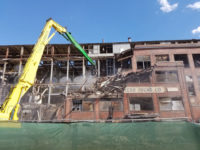In the 1950s, during the Cold War between the United States and the Soviet Union, 30 million tons of uranium ore were mined on or adjacent to the Navajo Nation in northeast Arizona and northwest New Mexico. The rare heavy metal was stockpiled for use in nuclear weapons.
The result, post-Cold War, are 500-plus abandoned mines. Beginning in 2008, the EPA conducted preliminary investigations, and four years later, partnering with the Navajo Nation, identified 46 of these as “high priority” based on radiation levels, proximity to homes and potential for water contamination.
Uranium is a hazardous substance and its release or potential release requires action under the Comprehensive Environmental Response, Compensation and Liability Act (CERCLA or the Superfund Law).
To date, the EPA has reached $1.7-billion of enforcement agreements and settlements with a variety of companies to reduce the highest risks of radiation exposure. So far, cleanup or stabilization work has been completed at nine mines, 51 contaminated structures have been remediated and 3,013 Navajo families now have safe drinking water, in coordination with the Indian Health Service.
One recent settlement is with EnPro Industries, a mid-sized manufacturing company with approximately 6,000 employees based in Charlotte, North Carolina. The company was formed in 2002 as a spinoff from the Goodrich Corporation, now part of United Technologies Corporation.
EnPro is accessing eight abandoned mines, all near Cameron and Tuba City. Two of these are high priority.
The company expects to complete the two high-priority remedial site assessments by Dec. 31 and the remainder in 2019, says Benne Hutson, director, Environmental, and deputy general counsel for the company, which posted approximately $1.5 billion in sales in 2017.
In the 1950s, the mines were owned by the now-defunct A&B Mining Corporation, whose operations contributed to the contamination of the eight sites. Hutson says that of the companies that own the abandoned mines, EnPro Industries has the fewest number, at eight.
The company assumed ownership as a result of mergers during the last 60-plus years. “If I made a flow chart of the ownership of the mines, it would crash ancestry.com,” Hutson says.
A standard scenario for the 1950s was that miners would excavate exploratory holes 6 inches to two feet to extract ore samples that might meet the government’s uranium quality standards.
“Often, this was pick-and-shovel work, with horse-drawn wagons taking the ore back to a pick-up truck, which brought it in for testing,” Hutson says. “Remember, this was taking place some 65 years ago.”
Through its contractor, the Denver office of Arcadis, EnPro will perform radiation assessments, specifically soil-sampling, prepare cultural resources and biological surveys. Hutson says he anticipates that Arcadis will work on the project from assessment through any remediation work.
The two high-priority sites are surface mines at the top of mesas, less than a couple acres each; they are designated A&B #2 and A&B #3, he says.
“We are now determining the nature and extent of the contamination,” he says. “Then we will develop a plan for remediation. Part of the challenge right now is that we can’t do field work until September because of the high-temperature issues in that part of Arizona.”
Another overall challenge: “There is naturally occurring uranium all over the area, so where is the boundary between mining activity and what is naturally occurring?”
Hutson estimates the assessment costs at a “couple million dollars” for the eight sites. “Right now we are paying the EPA oversight costs but are reserving our right for cost recovery,” he says.
If remedial work is eventually required, Arcadis will likely contract this work. “We recognize that employment is a critical issue for the Navajo Nation and we want to make sure there are opportunities so that Navajo firms can be considered,” Hutson says.
For more information, please see epa.gov/navajo-nation-uranium-cleanup.




Post a comment to this article
Report Abusive Comment